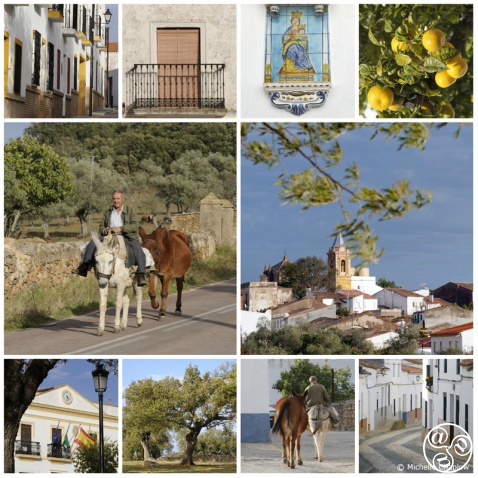
Cumbres de San Bartolomé - rural scenes and quaint streets with Portuguese cobblestones. |
|
Cumbres de San Bartolome
by Saskia Mier
Cumbres de San Bartolomé is located within the Sierra de Aracena and Picos de Aroche Natural Parkin the far north of Huelva province, west of Cumbres de Enmedio and 4km from the border of Extremadura. It has a population of around 500 inhabitants.
The origin of the town dates back to the Celtic occupation. Anarchaeological site has a castle as a highlight, whose artillery wall dates from the 13th century.
 |
| Cumbres de San Bartolomé and the Iglesia de San Bartolomé. |
History
Cumbres de San Bartolomé has its origins in Nertobriga Concordia Julia, a Roman town of Celtic origin. In the middle of the 13th century it was reconquered from the Muslims and became part of the Christian Kingdom of Seville.
The 13th-century artillery walls formed part of a fortifications chain across the Sierra de Aracena known as the Galician strip, so-called because the towns were repopulated by settlers from Galicia and Leon after the Reconquest. This strip extended along the northern border of the Kingdom and was a disputed area, since Portuguese and Spanish territories along the eastern bank of the river Guadiana were not well marked. The defensive structure was initiated by King Alfonso X of Castilla and continued by his son Sancho IV el Bravo.
After the treaty of Alcaçobas-Toledo in 1479, hostilities ended and the strength of Torres washanded over to the Order of Santiago. In 1594 Cumbres de San Bartholomé became part of the Kingdom of Seville in the Sierra de Aroche.
 |
| Rural life in Cumbres de San Bartolomé. |
THINGS TO SEE
Cumbres de San Bartolomé boasts houses in traditional style with some interesting details on their walls, gates and shutters. It is as if time had stood still and the experience is summed up in these historic details, making the visit highly memorable. Also worth seeing are the town's great views of neighbouring Extremadura, the Sierra de Aracena and over to Portugal, without forgetting the views towards the nearby villages of Segura de Leon and Cumbres Mayores.
Piedra de Utrera is a rocky outcrop outside the village which, along with the mirador (viewpoint), offers fine views over the surrounding countryside.
El Castillo
The latest research shows the castle of Cumbres de San Bartolome dating back to the 14th century as a medieval fortress. It has a rectangular enclosure in which stand both square and round towers. The internal structures and certain wall paintings are deteriorated, since part of the castle materials have been reused for the construction of houses and other domestic areas. Abundant vegetation can be found on the walls and inside the rectangular bullring, whose perimeter wall is made from concrete blocks painted red, with white markings to look the part. The castle is not usually open to the public, although visits are sometimes organised as part of the Castillos de Huelva programme. Located on Calle Espiritu Santo.
Iglesia de San Bartolomé
The Iglesia de San Bartolomé (church) has three interesting late-Gothic stone entrances dating back to this century, as well as details showing the transition from Gothic to Isabel line style. In the interior you can see a number of polychrome wood carvings of great interest: two Romanesque examples, the Virgen de Torre from the13th century, and Santa Ana with the Virgin (or Virgen del Pajarito) from the late 14th century. In addition, the image of the Virgin of Aliseda from the15th century, and a crucified Christ from the 17th century. This church is located in Plaza de España.
Mansion Houses
Casa de Cura is a mansion of great interest and dates back to the 19th century and first quarter of the 20th century. In addition, Casa Capitular is now the town hall, complete with clock.
Fountains
Fuente de la Villa is the village fountain, located in Plaza del Pilar, which still supplies fresh water - the last one built in this distinctive Sierra de Huelva style. The fountain is within a sunken, fenced area, with the water flowing into a semi-circular trough, and seating where residents can wait to fill their receptacles.
Squares
The village has three squares: Plaza de España (with church and town hall) is the largest and also known as the paseo, with the church on one side; Plaza del Pilar, with the fountain, also known as Abajo (the low one); and Plaza de San Sebastian, also known as Arriba (the high one).
Hotels near Cumbres de San Bartolome
Book Hotels near Cumbres de San Bartolome
GASTRONOMY
Regarding the gastronomy of Cumbres de San Bartolomé, the most popular ingredients are wild ceps such as tentullos and gurumelos, traditionally eaten with Iberican pork.
HANDICRAFTS
Cumbres de San Bartolomé still produces traditional crafts such as lace embroidery as well as basket weaving.
FESTIVALS
Romería Virgen de la Aliseda
A pilgrimage of walkers and horse-riders is celebrated at 9.30am on the third Sunday in May, one of the most popular festivals for the villagers. (More from Huelvapedia in Spanish)
San Bartolomé
Festival of the patron saint celebrated around 24 August. Morning mass is followed by a procession. Traditionally on 25 and 26 Augustin the afternoon, cows are let loose for the younger villagers to practice their bullfighting skills. (More from Huelvapedia in Spanish)
Virgen de la Aliseda
Celebrated from 30 August to 8 September. A church mass is held every afternoon and on the evening of 7 September a dance takes place with music. Morning mass is held on the morning of 8 September followed by a procession through the streets of the village.
LOCATION
Cumbres de San Bartolomé is located 130kms from Huelva on the Autopista del Quinto Centenario. After the detour to the N-435 to Valverde del Camino, passing this village, continue along the N-435, turning left onto HU-2111 towards Cumbres de San Bartolomé.

